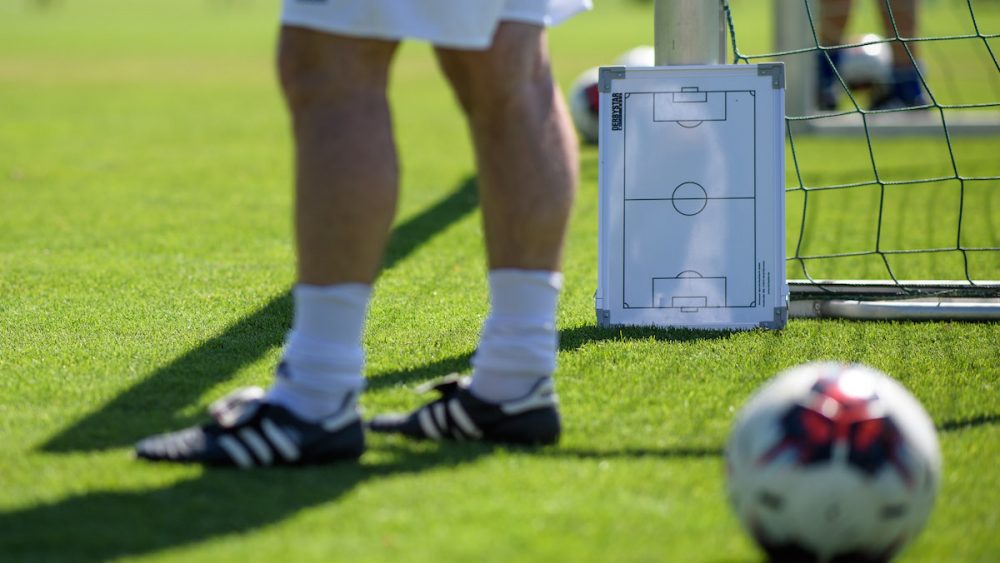Tactics blog #003 – the basics of pressing
In almost every tactical analysis here on our blog we dissect the quality of Bayern’s pressing or the opponent’s pressing. We use terms like “gegenpressing”, “attack pressing”, “midfield pressing”, “defense pressing”, “man orientation” or “space orientation”. But what do they mean exactly? High time to shed some light on these terms here in this piece.
In the past, people used to talk about “forechecking” when they meant that the team without the ball pushed forward as a unit to disrupt their opponent’s build-up play. But nowadays, this term is often wrongly equated with the notion of pressing as it is used today.
The German Wikipedia defines pressing as follows: “Pressing is the act of (momentary, prolonged, or permanent) closing down an opposing player or players in possession.” However, it will become clear later in this article that this definition is incomplete. For during defensive pressing there can be no talk of closing down at all, and yet it is described as a kind of “pressing”.
It would be more accurate to say that, in addition to the classic closing down, pressing also refers to the formation and organization of a team against the ball, which is intended to make it more difficult for the opponent to score goals. While the common definition thus implies above all that the opponent is put under pressure by closing down the ball-carrying opponent as early as possible, there are also varieties of pressing that do not involve direct and aggressive forms of attacking the opposing player on the ball. Lucien Favre, for example, insists that his players hold their positions in the game against the ball and do not close down opponents unnecessarily.
The level of pressing
Attack Pressing
What the quoted Wikipedia definition explains is best subsumed under “attack pressing”. In attack pressing, a team puts pressure on their opponent as early as possible. “Early” in this context refers to the progress of the opponent’s build-up play. Some teams decide to press as early as the goalkeeper, others start with the defensive back line. Regardless of such differences in detail, a team that deploys attack pressing takes up an average position deep in the opponent’s half. Bayern practised this form of pressing consistently under Pep Guardiola, and now again most recently under Hansi Flick. A particular advantage of this form of pressing is the enormous pressure that can be exerted on an opposing team. On the flip side, however, there is a constant risk of conceding counter-attacks when the opponent has managed to play through the first pressing line.
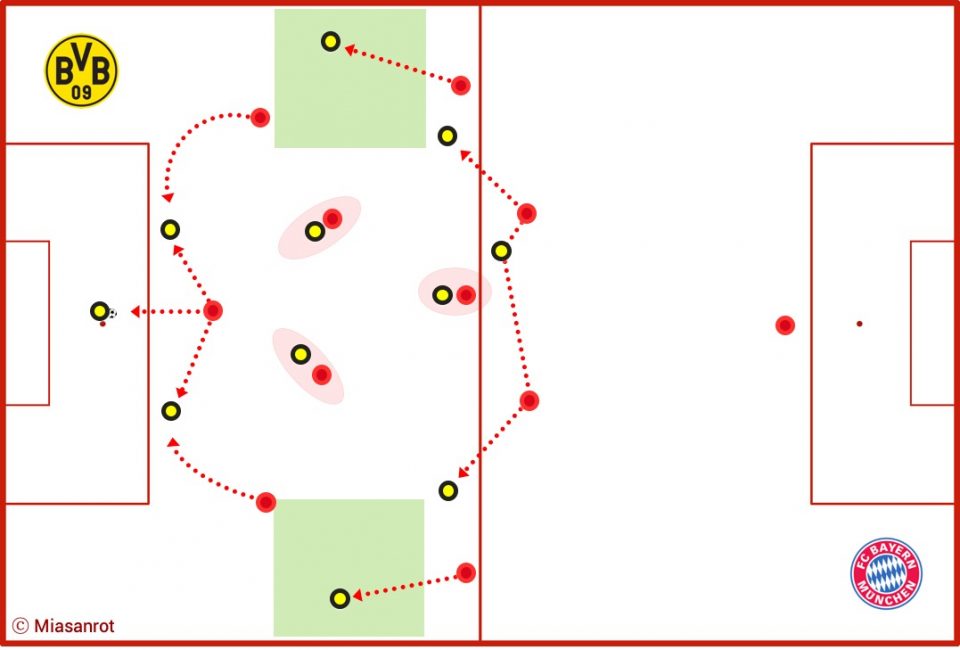
Midfield Pressing
Since the high intensity demanded by a determined attack pressing can hardly be maintained for a full 90 minutes, teams deal differently with the intermittent phases in which they have to moderate the intensity of their play to take a breath and recover energy. Guardiola tends to use periods in possession to recover, while Diego Simeone does so by varying the average positioning of his team. His Atlético side skilfully alternates between phases of attack and midfield pressing. During midfield pressing, the opponent is allowed to build up their game more or less unopposed. Instead of aggressively closing down the opponent early, midfield pressing attempts to block the opposing players’ vertical passing lanes. In comparison, the team is positioned a bit deeper and tries to win the ball by way of smart positional play rather than aggressively closing down the opponent. However, this does not necessarily mean that the team is passive. It is only that the point where the pressing is launched is located slightly deeper on the pitch, usually somewhere in the middle of the park. A key advantage of this is that a team can put pressure on their opponents and still maintain a relatively deep last line of defense close to their own goal. On the other hand, midfield pressing can also be too passive if the opponent possesses a strong build-up play. An effective midfield pressing is dependent on strong discipline and a good organization. Nevertheless, most teams mainly use midfield pressing.
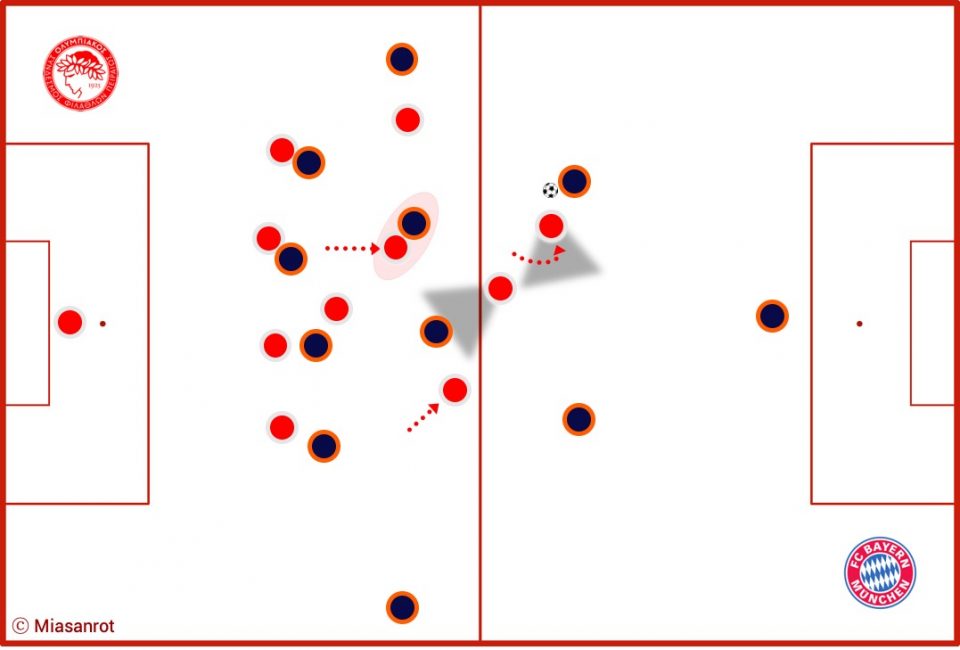
Defensive Pressing
Defensive pressing gives the opponent even more latitude in their build-up play. This type of pressing is sometimes described somewhat derisively as “parking the bus”. The most memorable example for Bayern fans will likely be the Champions League final against Chelsea 2012. The principle of defensive pressing is similar to that of midfield pressing, only that here the team’s center of gravity is pushed even further back, causing the spaces for the opponent in the attacking third to become particularly tight. The big disadvantage of defensive pressing is that, as a rule of thumb, it becomes the more difficult to create periods of rest the deeper a team sits in their own half. The distances a team has to cover during counter-attacks also become longer and longer.
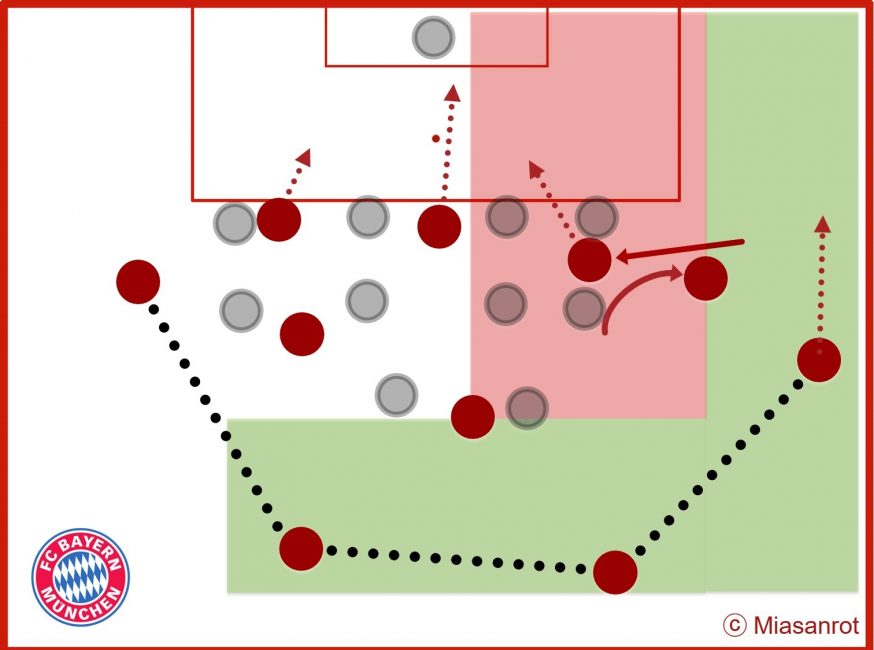
Important: These three pressing variations go hand in hand. Only the focus varies from team to team and coach to coach. A competitive team should be able to execute them all effectively.
The orientation
In addition to position on the pitch, orientation also plays a major role in pressing. Teams move around the pitch in order to defend certain spaces for certain reasons. Defensive lines (especially nowadays) are organized in such an intricate way that certain orientation points are used to guide the execution.
Man-oriented pressing
In man-oriented pressing, the orientation points are the opposing players. At its simplest, this means that the ten outfield players of the one team man-mark the ten outfield players of the other team so that every player has a direct opponent. The advantage is obvious: In theory, there are no more unmarked players, putting significant pressure on the team in possession. On the other hand, such a system is difficult to implement in this day and age. Physically, but also mentally, man-oriented pressing is especially demanding when the opponent works with many runs and positional changes. A team employing this tactic is very dependent on the individual class of its players and their capability to win direct defensive duels. Exceptional players like Thiago often manage to win such duels when pressed and then the whole opponent’s pressing scheme threatens to fall apart. That is why only a handful of coaches still use man marking across the entire pitch. André Schubert did this at times against Bayern in 2015 – not without success, his Gladbach side won 3-1. However, it is not uncommon to use man marking in certain situations and it does not necessarily have to be done all over the pitch.
Space-oriented or zonal pressing
As the name suggests, space-oriented pressing bases its execution on areas on the field. What happens in which areas differs from coach to coach and team to team. In a midfield pressing, it can be about defending the midfield center. Hence, it is not only the level of pressing that is important, but also the organization and positioning. In which formation does the team defend? Who occupies what space and with what goal? The focus here is on defending the areas that are considered dangerous or key for making one’s own game. It is also possible to create overloads in certain areas of the pitch.
Ball-oriented pressing
A third variation is ball-oriented pressing. In this case, the players do not orientate themselves mainly by their opponents or certain areas of the pitch, but they orient themselves mainly by the position of the ball. For example, if the ball is on the left side of the pitch, each player shifts to the left within the team’s formation.
Important: It is important to note that these three variations (can) be used together in a match. In the example of Flick’s Bayern against Dortmund shown above, it is evident that all three factors play a role: Man orientation (in the center), space orientation (organization, as well as a deliberate vacation of the wide spaces) and ball orientation (shifting according to the ball). All three forms can be further broken down and combined – there is, for example, man-oriented zonal marking, as this excellent piece by René Marić on spielverlagerung.de shows (in German).
Additional terms connected with pressing
Gegenpressing
Gegenpressing is often associated with Jürgen Klopp, but is now practiced by a lot of teams around the world. It refers to an immediate switch to aggressively closing down the opponent after a turnover. According to Louis van Gaal’s four-phase model, a team temporarily is in a state of confusion immediately after losing the ball (transition). Gegenpressing is intended to pre-empt this. By positioning oneself in a way that allows each player to immediately close down his opponent in case they lose the ball while still in possession, the basis for a quick recovery attack is laid, which in turn is meant to take the opponent by surprise while they are still in transition. Many coaches assume that the maximum effective time between losing and regaining possession is about six seconds. If a team does not manage to recover the ball during that time, they will often drop back and try to restore their shape.
Trigger
Triggers are the moments that trigger a certain action in pressing. Take the example of Bayern’s pressing against Dortmund again: If the ball is played out to the wings, this triggers the full-back to push out and initiates additional mechanisms to isolate the opponent. If Bürki chips the ball to his left-back, the combination of “pass” and “chipball” can be the trigger for Pavard at right-back to launch into a full sprint. The advantage: Every player knows exactly what he has to do at any time.
Cover shadow
Cover shadow is another term that is often used in conjunction with a pressing situation. If player A of team A (RB Leipzig in the example below) positions himself in the passing lane between player B (the ball carrier) and player C of team B (Wolfsburg), he puts player C in his cover shadow.
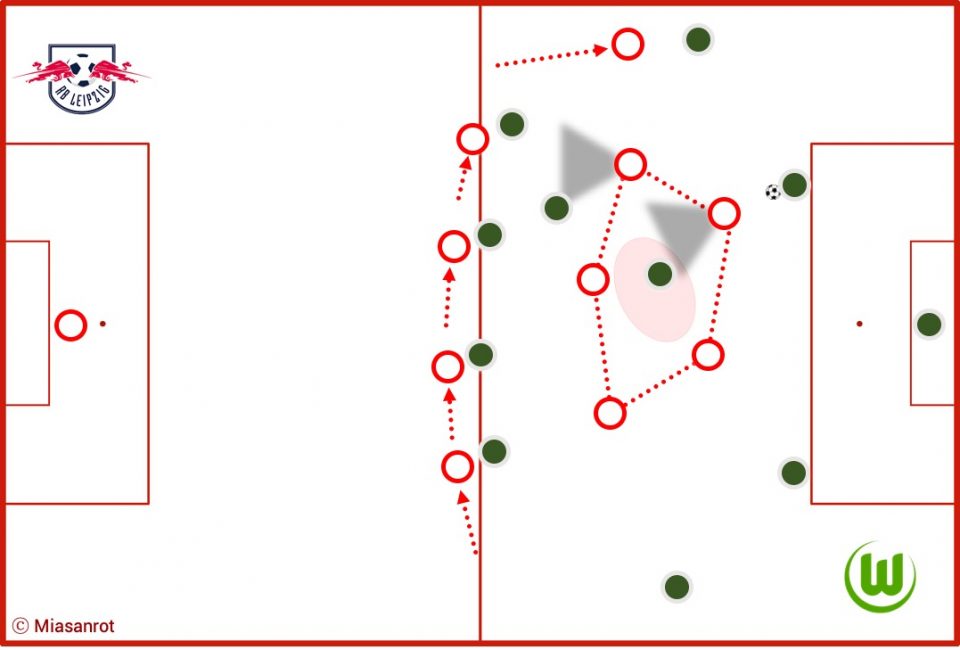
Key takeaways
- Pressing roughly refers to all actions the team not in possession takes in closing down an opponent and to recover the ball. It is not necessarily the same as “forechecking”, which is a special instance of pressing in which the opponent is aggressively closed down deep in their own half.
- The level of pressing can be divided into attacking, midfield and defensive pressing. They all go hand in hand and can be used in turns without the need to change the system.
- In pressing, a team organizes their actions based on the opposing players (man orientation), certain areas of the field (zonal or space orientation) or the ball (ball orientation). These variations, too, are not mutually exclusive and can be used within a system.
- Gegenpressing is an aggressive form of closing down the opponent after a turnover, which is already pre-structured by clever positioning when in possession of the ball.
- Triggers are recurring and previously defined processes during a game, which trigger a certain pressing action by a team.
Suggestions for further reading: Tactics lexicon by spielverlagerung.de (in German)

